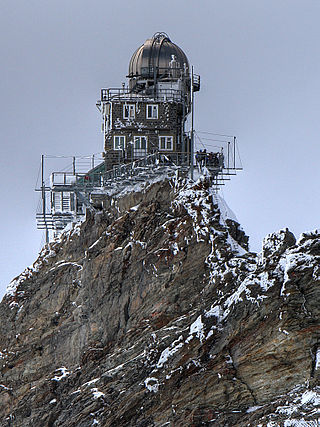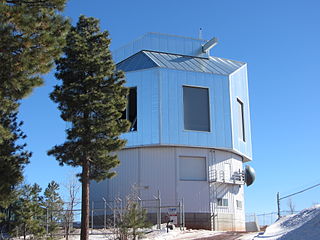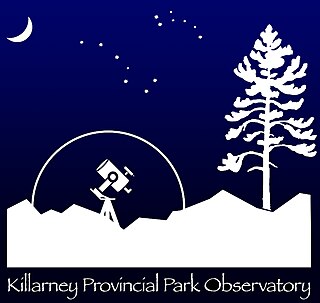
Amateur astronomy is a hobby where participants enjoy observing or imaging celestial objects in the sky using the unaided eye, binoculars, or telescopes. Even though scientific research may not be their primary goal, some amateur astronomers make contributions in doing citizen science, such as by monitoring variable stars, double stars, sunspots, or occultations of stars by the Moon or asteroids, or by discovering transient astronomical events, such as comets, galactic novae or supernovae in other galaxies.

The full moon is the lunar phase when the Moon appears fully illuminated from Earth's perspective. This occurs when Earth is located between the Sun and the Moon. This means that the lunar hemisphere facing Earth—the near side—is completely sunlit and appears as an approximately circular disk. The full moon occurs roughly once a month.

In astronomy, a conjunction occurs when two astronomical objects or spacecraft appear to be close to each other in the sky. This means they have either the same right ascension or the same ecliptic longitude, usually as observed from Earth.

An observatory is a location used for observing terrestrial, marine, or celestial events. Astronomy, climatology/meteorology, geophysics, oceanography and volcanology are examples of disciplines for which observatories have been constructed. Historically, observatories were as simple as containing an astronomical sextant or Stonehenge.

Lowell Observatory is an astronomical observatory in Flagstaff, Arizona, United States. Lowell Observatory was established in 1894, placing it among the oldest observatories in the United States, and was designated a National Historic Landmark in 1965. In 2011, the Observatory was named one of "The World's 100 Most Important Places" by Time Magazine. It was at the Lowell Observatory that the dwarf planet Pluto was discovered in 1930 by Clyde Tombaugh.

In astronomy, a transit is the passage of a celestial body directly between a larger body and the observer. As viewed from a particular vantage point, the transiting body appears to move across the face of the larger body, covering a small portion of it.

Observational astronomy is a division of astronomy that is concerned with recording data about the observable universe, in contrast with theoretical astronomy, which is mainly concerned with calculating the measurable implications of physical models. It is the practice and study of observing celestial objects with the use of telescopes and other astronomical instruments.

Catalina Sky Survey is an astronomical survey to discover comets and asteroids. It is conducted at the Steward Observatory's Catalina Station, located near Tucson, Arizona, in the United States.

NASA's series of Great Observatories satellites are four large, powerful space-based astronomical telescopes launched between 1990 and 2003. They were built with different technology to examine specific wavelength/energy regions of the electromagnetic spectrum: gamma rays, X-rays, visible and ultraviolet light, and infrared light.

Perkins Observatory is an astronomical observatory in Delaware, Ohio. It is owned and operated by Ohio Wesleyan University.

Fremont Peak Observatory (FPOA) is an astronomical observatory operated by Fremont Peak Observatory Association (FPOA) under contract to the State of California. Built in 1986, it is located in Fremont Peak State Park, near San Juan Bautista, California. Fremont Peak Observatory houses the Challenger telescope.

The Allan I. Carswell Astronomical Observatory, formerly known as the York University Astronomical Observatory, is an astronomical observatory owned and operated by York University. It is located in the North York district of Toronto, Ontario, Canada. Opened in 1969, York's observatory is opened to both researchers and amateur astronomers. The observatory was renamed the Allan Ian Carswell Astronomical Observatory in 2017 after York University Emeritus Professor of Physics Allan Carswell.

The International Year of Astronomy (IYA2009) was a year-long celebration of astronomy that took place in 2009 to coincide with the 400th anniversary of the first recorded astronomical observations with a telescope by Galileo Galilei and the publication of Johannes Kepler's Astronomia nova in the 17th century. The Year was declared by the 62nd General Assembly of the United Nations. A global scheme, laid out by the International Astronomical Union (IAU), was also endorsed by UNESCO, the UN body responsible for educational, scientific, and cultural matters.

The Lowell Discovery Telescope (LDT), formerly the Discovery Channel Telescope (DCT), is a 4.3 m (170 in) aperture telescope owned and operated by Lowell Observatory. The LDT was built at a dark sky site in the Coconino National Forest near Happy Jack, Arizona. Happy Jack is located at an elevation of 2,360 m (7,740 ft) and is approximately 65 km (40 mi) south-south-east of Flagstaff. The project was initially a partnership between Discovery Communications and Lowell Observatory. The research partnerships have been extended to include Boston University, The University of Maryland, The University of Toledo, and Northern Arizona University. The telescope cost $53 million. It significantly augments Lowell Observatory's observational capability and enables pioneering studies in a number of important research areas.
Astronomy Now is a monthly British magazine on astronomy and space. According to the Royal Astronomical Society, Astronomy Now is the "principal amateur astronomy magazine in Britain" with a reputed circulation of 24,000.

Discovery and exploration of the Solar System is observation, visitation, and increase in knowledge and understanding of Earth's "cosmic neighborhood". This includes the Sun, Earth and the Moon, the major planets Mercury, Venus, Mars, Jupiter, Saturn, Uranus, and Neptune, their satellites, as well as smaller bodies including comets, asteroids, and dust.

The Killarney Provincial Park Observatory is an astronomical observatory located at the George Lake Campground of Killarney Provincial Park . The Observatory is operated by Ontario Parks and houses two observatory buildings. The original facility contains a 10" telescope with solar filter, ideal for nighttime as well as daytime viewing of the Sun. The newer facility contains a 16" fully automated telescope with a 5" refractor and is ideal for research, astrophotography and public use. The telescopes are available for Discovery programs as well as private sign-out (self-use) by interested visitors.
International Observe the Moon Night is an annual public outreach event sponsored by the Lunar Reconnaissance Orbiter mission, the Solar System Exploration Division at NASA's Goddard Space Flight Center, and other NASA and astronomical organizations that encourages observation, appreciation, and understanding of the Moon and its connection to planetary science and exploration. Everyone on Earth is invited to join the celebration by hosting or attending an event or participating as a lunar observer — and uniting on one day each year to look at and learn about the Moon together. First organized in 2010, there are usually over 500 events annually in over 40 countries, hosted by universities, observatories, NASA Centers, schools, museums, parks, libraries, and amateur astronomers. Some events are offered both in person and via internet streaming video. The date is selected to enhance visibility of lunar topography.
The Asteroid Terrestrial-impact Last Alert System (ATLAS) is a robotic astronomical survey and early warning system optimized for detecting smaller near-Earth objects a few weeks to days before they impact Earth.
The International Lunar Observatory (ILO) is a private scientific and commercial lunar mission by the International Lunar Observatory Association of Kamuela, Hawaii to place a permanent observatory near the South Pole of the Moon to conduct astrophysical studies using an optical telescope and possibly an antenna dish. The mission aims to prove a conceptual design for a lunar observatory that would be reliable, low cost, and fast to implement. A precursor mission, ILO-X consisting of two small imagers, launched on 15 February 2024 aboard the Intuitive Machines IM-1 mission to the Moon south pole region. It is hoped to be a technology precursor to a future observatories on the Moon, and other commercial initiatives.
















